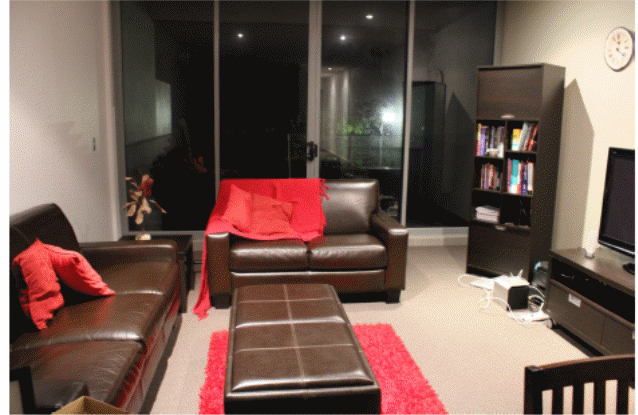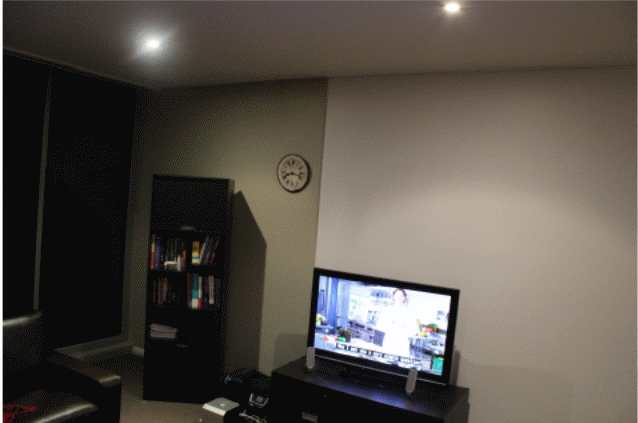The lighting inside a room makes a great difference. Lighting generally influences relations with elements inside the room and can transform the appearance and feel of the space alongside an individual’s idea and perception about it. It is therefore vital to assess the current lighting setting and improve upon them if necessary. The purpose of this essay is to focus on a living room, evaluate its roles, analyze the current lighting and propose a different method of improving space utilization.
The living room selected for this review is rectangular. It has a transparent wall made of glass and a door on the east side facing the balcony. The living area consists of a two-seat sofa on the east section, a distance of one meter separates the balcony and the sofa. On the north, there is a three-seat sofa. In addition, on the south side, one can locate the television screen and the table adjacent to a tall cabinet for books situated on the southeastern section of the room. Lastly, the room also consists of a large coffee table in the middle and additional coffee table situated in the northeastern corner. With regard to the room’s texture and colors, white paint has been used on both the walls and ceiling. Brown glossy leather was chosen for the sofas and the coffee table at the center. The cupboard and tables made from wood were dark brown in color (see figures 1 and 2).
The living room has multiple purposes. It is used as a conversation area for any social occasion, reading, watching television, general eating or listening to music. People in a living room tend to navigate the space with their eyes and observe its contents, decorations and watch television and gaze materials at the bookshelf. Living rooms are considered personal and intimate to their occupants and therefore a sense of welcoming ambiance is required in such a place. Normally, occupants of houses tend to spend most of their time relaxing. It is therefore necessary for lighting to account for the desired mood of occupants (Steffy 1990). Overall, occupants should derive visual satisfaction from the living room.
The reviewed living room lighting system has four 50-watts Tungsten halogen bulbs that form a square shape in the middle of the ceiling. The four bulbs emit yellow lighting with strong, intense light (see figure 3). Clearly, the installed lighting system does the role of highlighting the living room. It does not serve this purpose effectively, apart from the central beam on the cupboard. According to D’Aprano and Diprose (2013), halogen reflector lamps are not considered as the best options for normal purpose living room. This has been identified as a common mistake in interior lighting. One can observe shades in the east side of the living room and the upper parts of the walls. This situation affects the general ability to see other contents of the room such as the wall clock. In addition, it creates a sense of anxiety in the room. Further, the position of the light creates a beam and intensity that impairs visual abilities because of extremely glowing bright lights in wrong locations. The glare is most likely to affect people seated on the sofas. This may create eye fatigue and impair other visual activities such as watching television. Finally, the installed lighting cannot sufficiently meet readers’ lighting requirements.
The proposed lighting alternative to the living room is based on its functions, visual tasks and the installed design patterns. First, it is imperative to install lighting that creates ambient light in the location with most activities within the room. It is believed that ambient lighting will offer better lighting for the room and ensure that all items and people in the room are visible (Karlen, Benya, & Spangler 2004). The room will have adequate bright light to highlight sofas and coffee table at the center, as well as sufficient lighting for navigating the entire room. Second, the living room should have portable lamps for certain visual tasks like reading. Reading usually needs medium to high lighting based on the size and texture of the text and paper respectively (Di’Louie 2008). A portable lamp will therefore bring convenience to occupants when reading and performing other related tasks. Lastly, the design should also introduce another central glow on the cupboard to illuminate its contents and highlight that section of the living room. Smith and Bertolone (1986) noted that this method highlights and draws occupants’ focus to the least lit areas of the room. According to Di’Louie (2008) and Fielder and Jones (2001), a living room should have low to moderate mode of lighting. The living room space, however, has varied roles, a situation that makes it critical to regulate the lighting glow. Steffy (1990) had observed that lighting flexibility could result in creating some preferred moods in the room. When one opts for a cinematic atmosphere or an intimate mood, for instance, dimmer switches could be used to create low illumination within the room. This implies that an alternative dimmer switch may also be introduced in the living room.
Overall, the essay has focused on the living room as a space for improvement, offered explanations on its varied functions, strived to provide critical overview of the installed lighting and offered an alternative method of enhancing lighting in the living room. The currently installed lighting is not appropriate for the living space. Therefore, the proposed alternative will assist in overcoming these challenges.
Figures of the Living Room



Reference List
D’Aprano, A & Diprose, S, 2013, Section 4: Energy Efficient Lighting, Lamp choices, viewed 2 Febreuary 2015, via Electrical Energy Efficiency Starter Kit. Web.
Di’Louie, C 2008, Lighting Control Handbook, The Fairmont Press, Lilburn, GA.
Fielder, W & Jones, F 2001, The Lit Interior, Architectural Press, Oxford.
Karlen, M, Benya, J & Spangler, C 2004, Lighting Design Basics, John Wiley & Sons, New York.
Smith, F & Bertolone, F 1986, Bringing Interiors to Light, The Principles and Practices of Lighting Design, The Whitney Library of Design, New York.
Steffy, G 1990, Architectural Lighting Design, Van Nostrand Reinhold, New York.